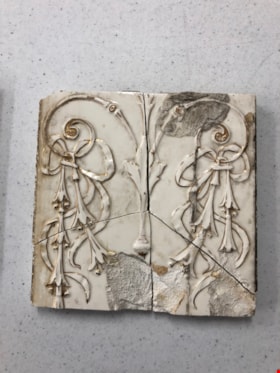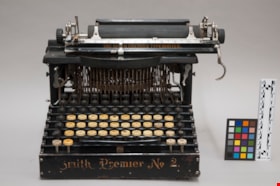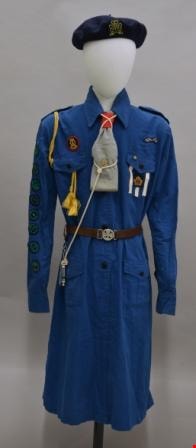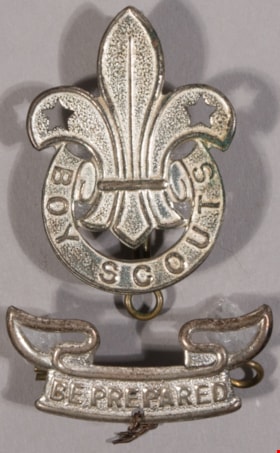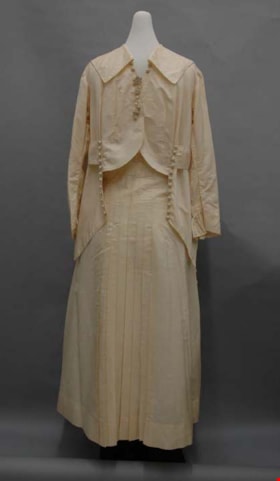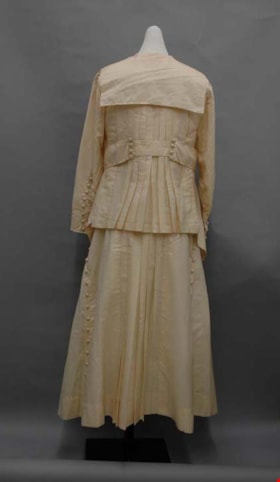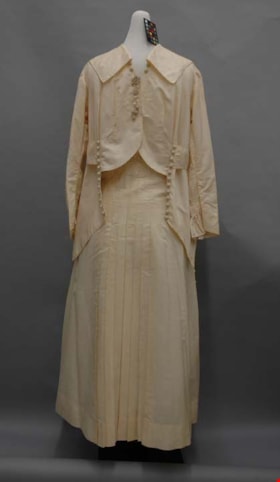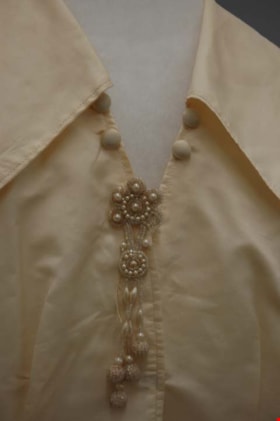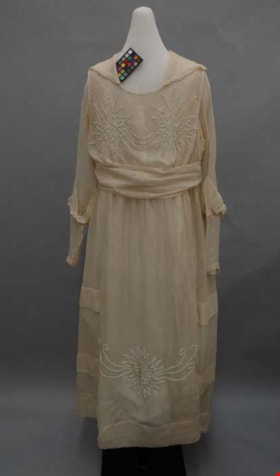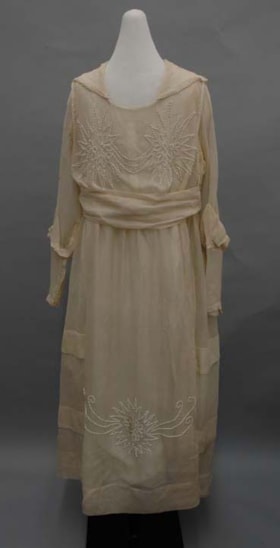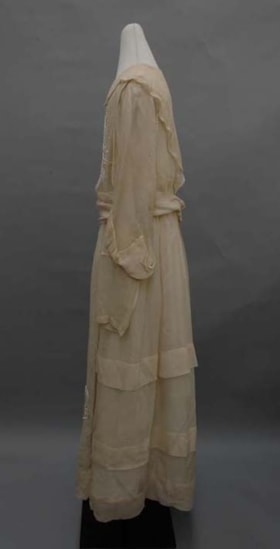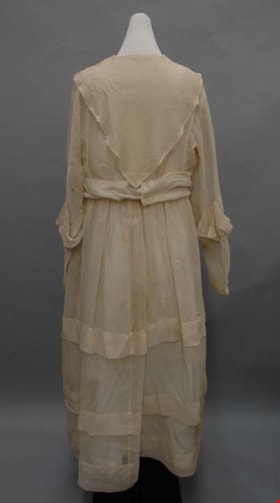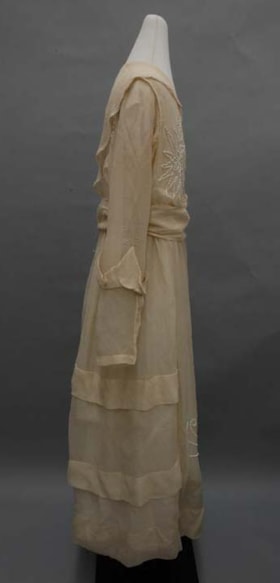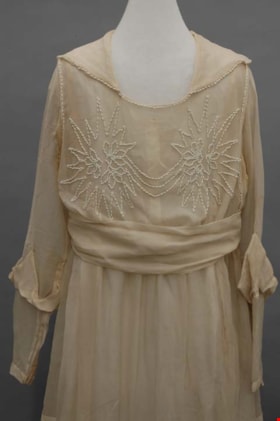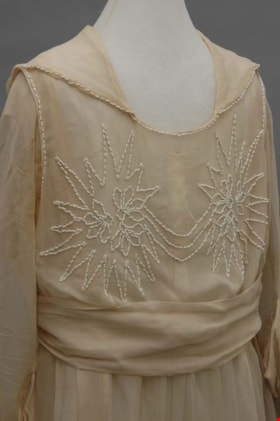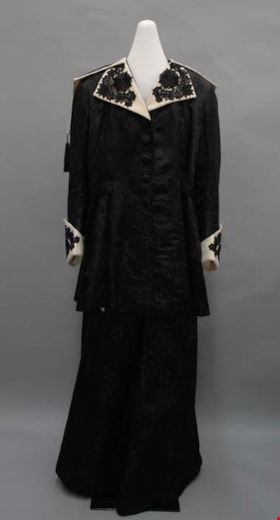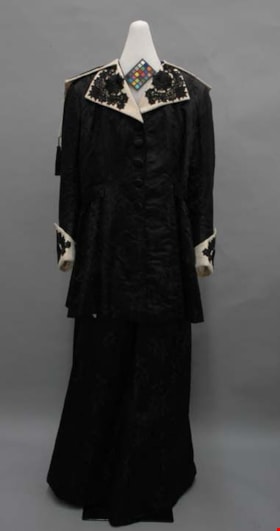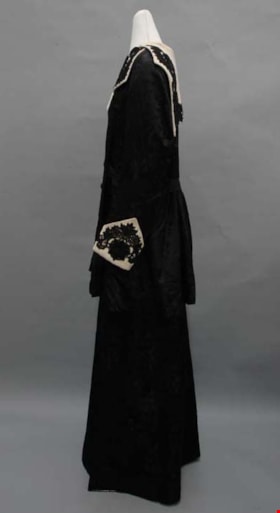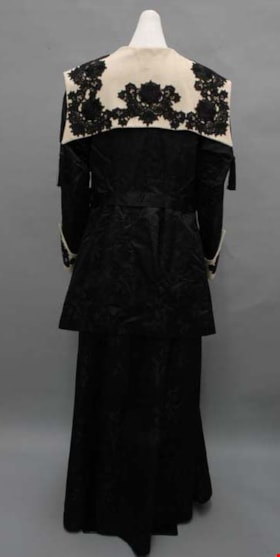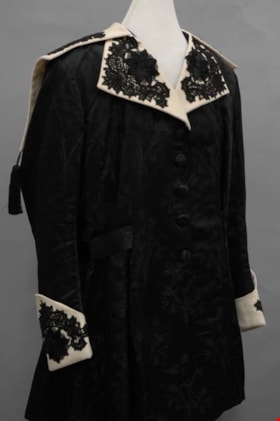Narrow Results By
Person / Organization
- B.C. Summer Games 1
- Bingham, Alfred "Alf" 1
- Boy Scouts of Canada 2
- Burnaby Centennial '71 Committee 1
- Burnaby Municipal Police 1
- Burnaby Rhododendron and Spring Flower Show Society 1
- Burnaby Village Museum 2
- Cassels, Frederick Homer 1
- Chakowski, Maryanne 1
- Corsbie, Joseph Hardcastle-Cumberland "Joe" 1
- Galbraith, Eleanor Lois 1
- Gilbert, J.R. 1
Tile
https://search.heritageburnaby.ca/link/museumartifact90836
- Repository
- Burnaby Village Museum
- Accession Code
- BV020.40.21
- Description
- White ceramic tile with gold design. The design is made up of a gold line down the centre with a leaf comprising the top half. Two gold curls emerge from either side of the line. Six bell-shaped flowers hang from these gold curls on each side and are tied with a ribbon. There is a large brown stain on the top right corner with two rough chips out of the bottom. This tile is split into nearly 4 equal parts.
- Object History
- These tiles are from Glenedward Mansion, built in 1912. It was built at 3412 Kingsway, which later became 5152 Kingsway. They were salvaged when the mansion was demolished in the 1990s.
- Category
- 01. Built Environment Objects
- Classification
- Building Components - - Surface Elements
- Object Term
- Tile, Decorative
- Colour
- White
- Gold
- Measurements
- 6" x 6"
- Subjects
- Building Components
- Buildings - Heritage
- Historic Neighbourhood
- Edmonds (Historic Neighbourhood)
- Planning Study Area
- Windsor Area
Images
typewriter
https://search.heritageburnaby.ca/link/museumartifact83395
- Repository
- Burnaby Village Museum
- Accession Code
- BV007.30.1
- Description
- Full-keyboard upstrike Smith Premier No. 2 typewriter made by Smith Premier Typewriter Company, 1904. It features a double keyboard, with rows of lowercase letters at the bottom and uppercase letters at the top. It includes typewriter, carrying lid, wooden platform, two typewriter ribbon spools, and an unrelated box that holds the spools.
- Object History
- Donor found object in an old building in Vancouver, ca. late 1950's - early 1960's. Smith Premier manufactured double keyboards until 1921, long after their competitors had introduced the "Shift" key which allowed each key to type both an upper and lowercase letter.
- Reference
- http://www.typewritermuseum.org/collection/index.php3?machine=smithpr1&cat=ku
- Country Made
- United States of America
- Province Made
- New York
- Site/City Made
- Syracuse
- Subjects
- Written Communication Tools and Equipment
- Written Communication Tools and Equipment - Typewriters
Images
uniform dress
https://search.heritageburnaby.ca/link/museumartifact87413
- Repository
- Burnaby Village Museum
- Accession Code
- BV015.36.62
- Description
- Uniform dress – long-sleeve blue cotton uniform dress, four (4) black buttons with GGC & trefoil logo down front of dress, two breast flap pockets with brown button closures, two hip flap pockets with black button closures, two tab epaulets at shoulders with black button closures, tag inside collar reads: “OFFICIAL UNIFORM / GIRL GUIDES / ASSOCIATION / STORES DEPARTMENT / TORONTO, CANADA”. Wings (Brownie) sewn above left pocket. 2 year star with brown felt backing pinned to left pocket flap. Salvation Army Badge sewn on left pocket front. Three white stripes of adhesive cloth tape applied vertically to the front of the left breast pocket. Two B.C. Provincial Hat badges are pinned to the left collar point (these would not normally be worn on the uniform itself). Religion in Life badge (yellow alpha & omega symbols) sewn above right breast pocket. Gold Cord worn threaded through the right tab epaulet of the uniform dress and then hooked behind the button of the right breast pocket flap. Badges sewn vertically on right sleeve include: Woodcraft emblem (silver tree on right shoulder epaulet), must earn a group of other badges to get woodcraft emblem (outdoor activities); Little House emblem (Queen Elizabeth II’s doll house at top of right sleeve), must earn a group of other badges to get little house emblem (indoor activities); Hostess (green teacup & saucer), Laundress (green iron), Musician (green lyre), Fitness Fun (green figure with arms raised), Life Skills (green crossed keys), Sport (green figure with jump rope) Sewing (green scissors), Citizen (green maple leaf), Cook (green gridiron), Health (green serpent), Singing (green music staff with notes G, B, and D), Postal (green winged envelope), Writing (green feather quill & inkpot), Knitter (green yarn ball & needles), Reporting (green feather pen & paper), Fire Safety (green firefighter’s helmet), Swimming (green life preserver), Pioneer (green crossed pick & axe), Hiking (green Viking helmet woodcraft sign), Forestry (green deciduous tree), Astronomy (green Great Bear constellation), Camper (green tent) and Tracker (green rabbit tracks). Badges sewn vertically on left sleeve include: First Class Emblem (red ribbon of courage as border tying into a reef knot at bottom); Home Nurse (white cross), Child Care (green cross) and First Aid (red cross).
- Object History
- Salvation Army Guide uniform dress belonging to Virginia Blake, early 1960s. From the 6th Vancouver Salvation Army Guides on Hastings Street. Salvation Army was affiliated with Girl Guides (1937) of Canada until 1998. Worn with brown leather belt, beret, folded triangular company tie. The three white stripes on the right breast pocket indicate that wearer was a company leader. The more stripes you had, the higher your rank. A single white stripe, sewn down the center of the pocket, would have indicated that she was a patrol seconder. Two stripes would indicate that she was a patrol leader. White adhesive tape was used so that the Guider didn’t have to unstitch and re-sew the stripes as they gained rank.
- Category
- 03. Personal Artifacts
- Classification
- Clothing
- Clothing - - Main Garments
- Names
- Girl Guides of Canada
Images
uniform hat badge
https://search.heritageburnaby.ca/link/museumartifact41587
- Repository
- Burnaby Village Museum
- Accession Code
- BV001.6.10
- Description
- Badge, Boy Scout patrol leader's, for hat; in two pieces; "Boy Scouts"; split pin fastening; fleur-de-lis shape; lower part is ribbon motif, "Be Prepared" ; pre 1942
- Object History
- This badge was worn by the donor as a patrol leader prior to 1942.
- Names
- Boy Scouts of Canada
Images
wedding dress
https://search.heritageburnaby.ca/link/museumartifact3348
- Repository
- Burnaby Village Museum
- Accession Code
- BV989.39.1
- Description
- Wedding dress, 1917. Cream silk, jacket and skirt. Sailor collar, long sleeves, loose cut with fitting, beaded brooch, pleats and button trim on both pieces. The V neck has a large square sailor style collar, with two self covered ball buttons on either side just below the collar ends. At the V point there is a beaded floral brooch with tassels. The sleeves are loose fitting, trimmed with eight buttons at the forearm and gathered to half a cuff. The centre front of the bodice has a bust dart on either side, and cuts off at the waist. Here a belt attaches around the sides, trimmed with four buttons at either side front and back. The bodice's ivory silk lining is not pleated, and it is not attached at the bottom. It closes at centre front with two slide snaps. On the back of the jacket, there is a large pleat on either side. Centre back is fully pleated, and the pleats are sewn down from the neckline to underarm level. At the waistline, there is a narrower band of fabric that joins the side belts together and holds the pleats in place. The back of the jacket extends to the hips, and the sides extend several inches further and each end in a point. The skirt, made with six gores, falls smoothly over the hips. It has a pleated ruffle at the top and a waistband reinforced with a large grosgrain ribbon on the inside. The centre back and centre front are pleated from the waist to hem, the pleats sewn down to the end of the hips. Each side is trimmed with buttons spaced evenly from the waist to hem. The skirt closes at the right side back with slide snaps and hooks and eyes on the grosgrain.
- Object History
- Photocopy of the original wedding photo is in the acquisition file. Worn by the donor's mother, Mary Edith Pearl Collum (nee Dillabough). She married Eli Wilbert Collum on June 20, 1917, in Winnipeg (she was 25 years old). They moved to Vancouver in 1936, then to Burnaby in 1938. Edith gave the dress to her son first for safe keeping, and then as an inheritance. She passed away February 1, 1989 at age 97 (born 1892).
- Subjects
- Clothing
- Clothing - Costumes
Images
wedding dress
https://search.heritageburnaby.ca/link/museumartifact30794
- Repository
- Burnaby Village Museum
- Accession Code
- HV972.5.4
- Description
- Wedding dress, c.1913. The fabric is an ivory silk chiffon, lined in white satin silk. The skirt extends mid-calf, the sleeves three-quarter length, and there is white beaded decoration on the bottom front of the skirt, as well as the front of the bodice. The silhouette of this dress shows the then fashionable shape of a raised waistline, as well as the poufed blouse front that was still popular. The fabric is light, flowy, and airy, but the cut has straight lines in features such as the bodice panels and large skirt pin tucks. The bodice closes via a panel that hangs down the front, attaches to the waist, and extends down the bodice back. There is an additional panel that attaches on each side front neck, forming a collar, and hangs down the back in a triangular shape. The front panel closes on the left side at the waist and at the left shoulder with snaps. There are two beaded floral starburst patterns, one each on the left and right side of the front bodice panel, connected with three curved lines. There is also a single line of white beads along the edges of the front bodice panel, and both back panels, including the front and side neck. The sleeves connect to the dress lining under the bodice panels. Each has a hanging panel around the elbow line which looks like four triangle shapes that point upwards, tacked above the elbow line. The cuffs are narrowed with a dart and two pin tucks, with a hook and eye closure on a bound placket. Around the waist, there is a belt that connects to itself with snaps, and is tacked to the waistline in the centre back. There are two snaps on the left side waist that may have once been used to secure the belt, but the belt no longer has any corresponding snaps. The skirt is somewhat gathered at the waist, more in the back than the front, and consists of three slightly flared gores. The front gore is plain except for a white beaded floral starburst motif near the bottom front. Three beaded tendril lines extend from either side, spanning the width of the front gore. The other two gores each extend from the side fronts to the centre back; they each have two three inch pin tucks, just above knee level and one below, that hang downwards and extend to centre back. The lining is attached at the waist, and hangs freely under the skirt. It has a front and back gore, as well as two triangular gores on each side starting at knee level. In the bodice it is attached at the neck and shoulders, where it attaches to the unlined sleeves. It closes on the left front with hooks and eyes. Inside the lining, the waist is reinforced with three inch cotton grosgrain ribbon which closes at centre front with hooks and eyes. The dress is sewn mainly by machine with french seams, although the four inch hem is hand sewn with a whip stitch. The sleeve pin tucks are also hand sewn. The length of the skirt lining was reduced just above its hem with a one inch hand stitched tuck.
- Subjects
- Clothing
- Clothing - Costumes
Images
woman's suit
https://search.heritageburnaby.ca/link/museumartifact6270
- Repository
- Burnaby Village Museum
- Accession Code
- BV985.20.1
- Description
- Woman's suit, c.1917. Black silk brocade with a large collar decoration of ivory wool with black lace. Long sleeves with wool and lace cuffs, ankle length skirt. The neckline of the jacket has a large flat triangular ivory wool collar with black floral lace applique. On the back bodice there is an overlapping extension of the collar in a large square shape. The jacket opens in centre front with five self fabric buttons, ending slightly below the natural waistline. A belt that starts at the natural waistline, between the last two buttons, from the side front seams and continuing around the back. It is tacked to the jacket in several places. The sleeves are long with ivory wool cuffs that reach up to a point on the outside, and a black floral lace applique. The jacket is constructed so as to flare out from the waist. At each side front, there are two panels with a godet in between them. There are four back panels, with a godet on either side of the two centre back panels. There are also two godets at each side seam. There was originally off-white silk brocade, but it was replaced with silk charmeuse in restoration as the original lining was disintegrating. On the inside edge of the front closure, there is a facing under the buttons that continues around the back of the neckline in a thin strip. The shoulder seams are also set further into the back of the jacket. The skirt is made of seven gores, unlined. The front is somewhat gathered. The waistband has a grosgrain ribbon, and closes in the back with two hooks and eyes. the rest of the opening closes with six snaps. The hem extends to the ankles, and the seams are finished by pinking.
- Object History
- The suit belonged to the mother-in-law of a friend of the donor, named Dougan from Montana. It went to California from there, then British Columbia.
- Subjects
- Clothing
- Clothing - Costumes
